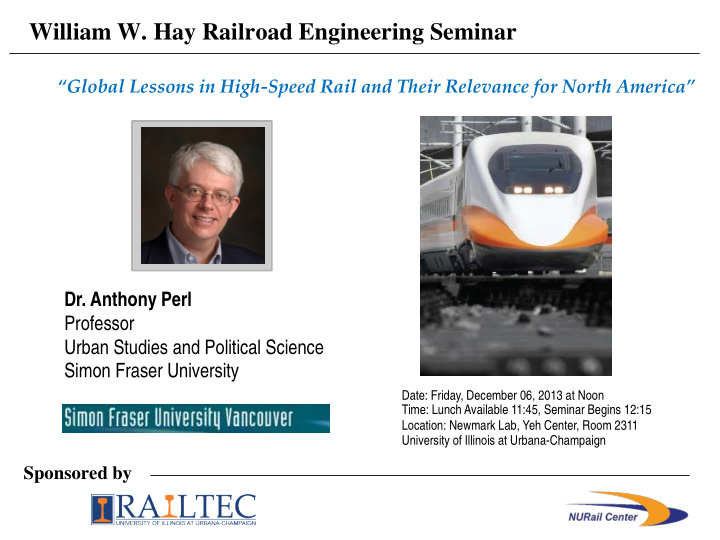



William W. Hay Railroad Engineering Seminar “Global Lessons in High-Speed Rail and Their Relevance for North America” Dr. Anthony Perl Professor Urban Studies and Political Science Simon Fraser University Date: Friday, December 06, 2013 at Noon Time: Lunch Available 11:45, Seminar Begins 12:15 Location: Newmark Lab, Yeh Center, Room 2311 University of Illinois at Urbana-Champaign Sponsored by
Global lessons in High-Speed Rail and their relevance for North America Anthony Perl aperl@sfu.ca
Americans have been early adopters of transportation technology that was invented elsewhere 1829 1830
Auto and jet aircraft technology were both launched in Germany, before taking off in the U.S.
Where America exceled was in re-imagining autos and aviation as mass transport modes
U.S. has long embraced mobility as a means to advance opportunity Travel and trade enable Americans to pursue a better life. Social mobility increased when the U.S. has introduced new transport technology.
After Japan launched the Shinkansen , America took the first steps to adapt and adopt HSR technology
President Lyndon Johnson signed the High Speed Ground Transportation Act in 1965
Americans quickly built a train that could reach very high speeds New York Central M-497 set the still standing U.S. speed record on rails - 183.85 mph, on… July 23, 1966!
Fast(er) trains entered commercial service in 1968 TurboTrain operated NY - Boston, until 1976. Schedule equaled today’s Acela . Reached 170 mph in tests.
Public-private partnership built America’s first high-speed EMU NY - DC Metroliner was product of a “public- private partnership” $12.9 million in federal funds leveraged $60 million from PRR, Budd, GE, & Westinghouse .
In the 1970s, Amtrak could boast that a 3 hour trip time from NY to DC made their train “one of the fastest in the world”
When Amtrak experienced many problems during its early years, Metroliner was the only train to consistently cover its operating costs
America’s fastest trains have been stymied by the tracks they need to operate effectively track.
Even in the Northeast Corridor today, tracks exact a heavy toll on Acela The ‘breadbox’
9 Presidents and 24 sessions of Congress after 1965 … … the U.S. holds the world record for time elapsed between launching HSR development and building tracks that are needed to operate it.
Why has HSR moved so slowly?
When HSR was gaining momentum in Asia and Europe, many U.S. railroads went through a near death experience
Billions went into bailing out bankrupt carriers when Uncle Sam got into running freight and passenger railroads
Railroad ownership wasn’t the only thing that changed during this crisis Government rewrote a century-long accumulation of rules and regulations
Railroads no longer had to serve everyone, they could focus on profitable market niches
Downsizing to carry profitable traffic led to reduced track capacity Some rights of way have potential capacity; 20,000 miles of railroad got converted to trails
While Asia and Europe perfected HSR… the United States reinvented ways to move moving freight profitably by rail
This strategy worked! U.S. railroads have been the only transport mode to post consistent profits since 2001
Smart money from big investors has moved into U.S. railroads
The infrastructure gap between North American freight rail innovation and Asian and European HSR development has widened
So what’s the matter with the U.S., Europe and Asia going their separate ways in reinventing railroads?
Climate and energy vulnerability are global problems that rail offers part of the solution to
Growing climate & energy risks are likely to drive future mobility changes
U.S. dependence on oil has gone up since the 1973 OPEC Embargo Source : USA Today , Sept. 19, 2013
U.S. economy depends on vehicles that don’t work well without oil
HSR offers proven technology for moving people without oil for travel up to 1,000 miles
Conventional wisdom: the mid-point of the world’s oil reserves gives plenty of time to plan adjustments
The oil we’ll burn tomorrow is physically different from the oil we’ve already used
Do we invest a trillion plus into new oil infrastructure or billions in transportation infrastructure that doesn’t need oil?
New mandates to restart HSR development given by the 2008 election
2008 election provided both Washington and state governments a mandate to invest in rail infrastructure
Taking full advantage of America’s lag in adopting HSR technology will pay dividends Trains, planes, and automobiles HSR
3 models of HSR have emerged, each with their own strategic orientation 1. Exclusive Corridors: linking mega-cities 2. Hybrid networks: blending new and conventional rail to extend HSR reach 3. Comprehensive National Networks: Making HSR a backbone of intercity mobility
Exclusive Corridors: linking mega-cities
Hybrid networks: blending new and conventional rail to extend HSR reach
Comprehensive National Network: Making HSR a backbone of intercity mobility
California is now the HSR design laboratory for the U.S.
No need to reinvent the know-how for exclusive corridors; this is the place for global partnerships
Global knowledge can support local experience in sharing tracks among intercity and regional rail passenger operators
Sharing tracks will be essential to getting HSR into mega-cities like Los Angeles and San Francisco
Sharing rights of way with freight railroads will require innovations that are unique to the USA
Climate and energy challenges will affect freight railroads too What will freight railroads need from government to adapt their business model in the decade ahead?
Building America’s first new rail infrastructure to move people between cities in over 100 years will advance essential capacities
Innovation will attract states looking to add rail to their intercity mobility mix
Institutionalizing that know-how could bring rail an exciting new role of moving more people and freight across the U.S.
Recommend
More recommend